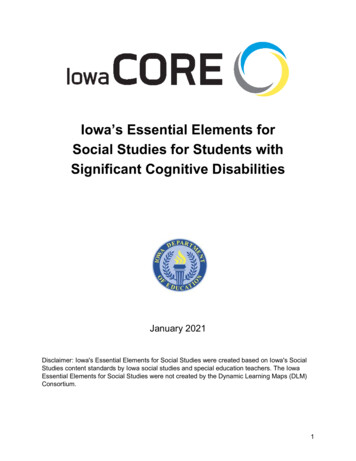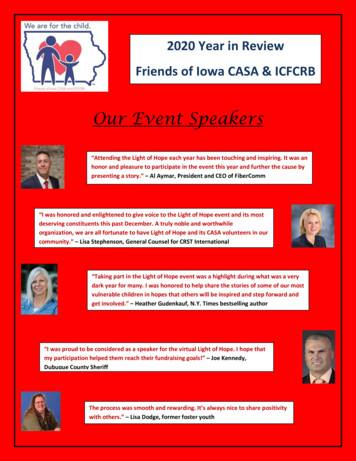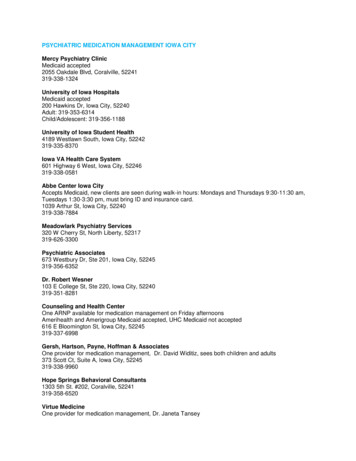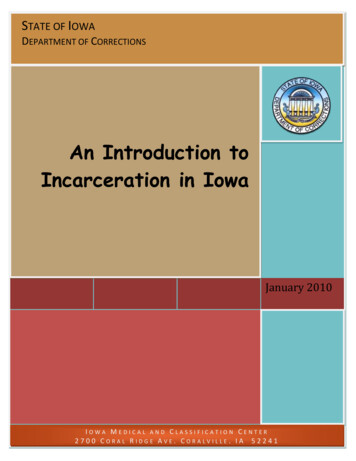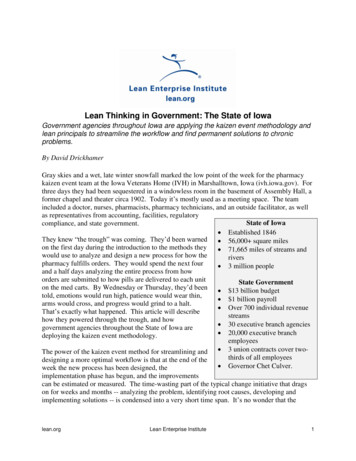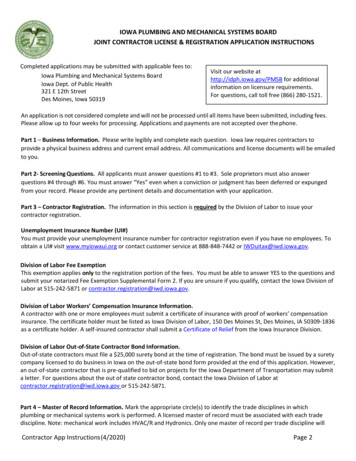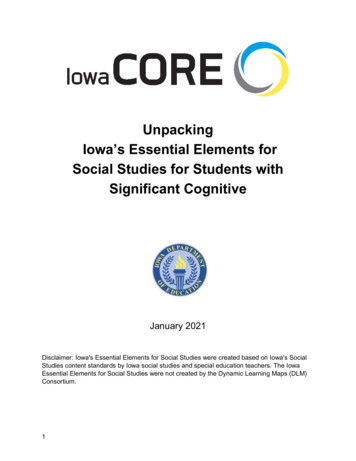
Transcription
UnpackingIowa’s Essential Elements forSocial Studies for Students withSignificant CognitiveJanuary 2021Disclaimer: Iowa's Essential Elements for Social Studies were created based on Iowa's SocialStudies content standards by Iowa social studies and special education teachers. The IowaEssential Elements for Social Studies were not created by the Dynamic Learning Maps (DLM)Consortium.1
ContentsIntroduction . 3System Alignment . 3Unpacking the Essential Elements . 4Color Coding of the Standards . 6Inquiry Anchor Standards . 6Content Anchor Standards . 6Kindergarten: Spaces and Places . 71st Grade: Communities and Culture. 132nd Grade: Choices and Consequences . 193rd Grade: Immigration and Migration . 264th Grade: Change and Continuity . 345th Grade: Right and Responsibilities . 416th Grade: World Regions and Cultures . 497th Grade: Contemporary Global Studies . 578th Grade: United States History and Civic Ideals . 659-12 Social Studies . 749-12 Behavioral Sciences . 779-12 Civics and Government . 839-12 Economics . 889-12 Financial Literacy . 919-12 Geography . 949-12 United States History . 989-12 World History . 1052
IntroductionThe Iowa Core Essential Elements (EEs) are specific statements of knowledge and skills linkedto the grade-level expectations identified in the Iowa Core Standards. The purpose of the EEs isto build a bridge from the content in the Iowa Core Standards to academic expectations forstudents with the most significant cognitive disabilities.This document provides a high‐level view of the relationship between the Iowa Core Standardsand the links to performance for students with the most significant cognitive disabilities. Thedocument is not intended as a stand‐alone guide to instruction, nor is it intended to contain allthe steps in a complete learning progression or detailed curriculum.These EEs are not intended as a redefinition of the standards. Rather, they are intended todescribe challenging expectations for students who meet participation criteria for instruction andassessment aligned to alternate academic achievement standards in relation to the Iowa CoreStandards. The EEs clarify the bridge between grade‐level academic achievement expectationsfor students with the most significant cognitive disabilities and the Iowa Core Standards.Neither are the EEs intended to prescribe the beginning or end of instruction on the content andskills they represent; rather, they indicate the grade level at which initial mastery would be thetarget to be assessed locally, at the district or building level.System AlignmentThe EEs are intended to contribute to a fully aligned system of standards, curriculum, teaching,learning, technology, and assessment that optimize equity of opportunity for all students in eachclassroom, school, and local education agency to access and learn the standards. To thedegree possible, the grade level Iowa Core EEs are vertically aligned and linked to the gradelevel Iowa Core Standards.The linkages provided by the EEs to the Iowa Core Standards are intended to increase accessto the general curriculum for all students with disabilities. Just as the EEs are designed todefine achievement in academic content areas linked to the Iowa Core, the EEs reframe theexpectations for foundational skills in pre‐academic and academic areas. Precursor/prerequisiteand the unique enabling skills related to English language arts content is specified in the contextof their roles as a foundation for students with the most significant cognitive disabilities toachieve skills related to academic content. The EEs are designed to allow students with themost significant cognitive disabilities to progress toward the achievement of state standardslinked to grade level expectations. The relationship of standards and assessment to teachingand learning are depicted for use by teachers, assessment designers, and users of alternateassessment results.3
Unpacking the Essential ElementsInstruction of the Iowa Core Social Studies Essential Elements requires thatLearning occurs through active participation and interaction with and exposure to meaningfulcontent Learning that builds over timeApplication of knowledge and skillsActive participation and interaction in learning activitiesCollaboration and communication (with adults and peers)Ongoing comprehensive instructionThe unpacked standards document identifies the concepts, skills, and essential questions foreach grade level cluster. This will help teachers understand what the student needs to know andbe able to do. It is important to note that the standards do not support isolated skill developmentbut conceptual understanding and skill development within context.As individuals read through the unpacking it is also important to understand that the concepts,skills, and key questions are written with vocabulary appropriate for the teacher. There is noexpectation that students would repeat the wording in these sections. The essential questionsshould help teachers think about skills, concepts, and expressive communication opportunities.Throughout the standards and the unpacked documents, communication implies a broad set ofbehaviors and combinations of behaviors which may or may not be a standardized form, butwhich convey intent (purpose for communicating) and are understood by the listener. Sinceacademic content is symbolic in nature, we must work to help students find ways tocommunicate what they know. We know this can be challenging for many students. Workingclosely with related services professionals and the students’ parents is key.The unpacked Iowa Core Social Studies Essential Elements provides teachers the concepts,skills, and essential questions: To set the expectation for the learning goals in an instructional unitAs instructional filters for selecting lessons and activitiesUnpacking means to identify the concepts and skills found in the cluster of grade level EEs. 4What does the student need to know (concepts and content)?What does the student need to be able to do (skills)?Is there a context in which the information is nested?To what depth of understanding should the information be learned (identifying, remembering,analyzing, creating, etc.)?
For every cluster the unpacked EEs document provides three components:1. Concept – Because the EEs were unpacked by cluster and not each Essential Element theconcept is inferred from all of the EEs in the cluster2. Skills – What might that look like for students with significant cognitive disabilities? Point Eye gaze Vocalize Use of AAC system (with or without switches, high tech or low tech) Partner assisted scanning3. Essential Questions Are more narrowly focused and point to the big ideas and concepts Provoke thought, discussion, inquiry, new understandings, and more questions Ask students to consider alternates, weigh evidence, support ideas, and justify answers Spark meaningful connections with prior learning, personal experience, and prior lessons Help students transfer knowledge to other situations and subjectsWhy use the unpacked document? Essentially, it is about good teaching. 5Teachers across the state have indicated unpacked standards will help them decide what isimportant for their students to learn, what concepts and skills students need to succeed,connect with high-level thinking skills, and engage students in the material by setting a purposefor learning.In short, it helps teachers create unit and lesson plans that connect within and across contentareas.
Color Coding of the StandardsThe standards are color-coded to allow for quick identification of the content area of the standard.Behavioral ial y Anchor StandardsEach grade level within the K-8 standards includes a set of inquiry standards. At the 9-12 level, there is one set of inquiry standards.These inquiry standards define key disciplinary skills within social studies. The inquiry anchor standards are the same throughout thedocument, but the standard that flows from each anchor standard is more complex as students move throughout their K-12 social studiesexperience. The inquiry standards should be taught in conjunction with the content standards.The K-12 inquiry anchor standards are: Constructing compelling questionsConstructing supporting questionsGathering and evaluating sourcesDeveloping claims and using evidenceCommunicating and critiquing conclusionsTaking informed actionContent Anchor StandardsEach grade level within the K-8 standards includes a set of content standards that encompasses the key disciplines that make up socialstudies. At the 9-12 level, these content standards are pulled out by the discipline. The content anchor standards are the samethroughout the document, but the standard that flows from each anchor standard is more complex as students move throughout their K12 social studies experience. The content standards should be taught in conjunction with the inquiry standards.21st century skills connected with the civics/government and financial literacy standards. This indicates that this standard shows up in thesocial studies standards and the 21st century skills standards.6
Kindergarten: Spaces and PlacesIn kindergarten, students will engage in learning about themselves, their school, city, and state. They will have opportunities to comparehow life in the past is different from life today with respect to their own experiences.Inquiry Anchor StandardInquiry StandardAlternate Inquiry AnchorStandardAlternate InquiryStandardConstructing CompellingQuestionsSS.K.1 Recognize acompelling question.Construct QuestionsEE.SS.K.1. Withguidance and support,recognize a questionabout a familiar topic.Communicating and CritiquingConclusionsSS.K.3. Construct responsesto compelling questions usingexamples.Communicating and CritiquingConclusionsEE.SS.K.3. Withguidance and support,identify an answer to aquestion.Taking Informed ActionSS.K.4. Take group orindividual action to helpaddress local, regional, and/orglobal problems.Taking Informed ActionEE.SS.K.4. Withguidance and support,identify a civic problemin their classroom.SS.K.5. Use deliberative anddemocratic procedures tomake decisions about and acton civic problems in theirclassrooms.EE.SS.K.5. N/AGathering and EvaluatingSourcesN/AGathering and EvaluatingSourcesN/ADeveloping Claims and UsingEvidenceN/ADeveloping Claims and UsingEvidenceN/A7
Content AnchorKindergarten: Spacesand PlacesAlternate ContentAnchorRecognize theInteraction Betweenthe Individual andVarious GroupsExamine Factors thatLed to Continuity andChange on HumanDevelopment andBehaviorSS.K.6. Describestudents’ roles indifferent groups ofwhich they aremembers including theirfamily, school, andcommunity.Recognize theInteraction Betweenthe Individual andVarious GroupsExamine Factors thatLed to Continuity andChange on HumanDevelopment andBehaviorSS.K.7. Describe waysin which students andothers are alike anddifferent within a varietyof social categories.AlternateKindergarten: Spacesand PlacesUnpackingEE.SS.K.6. Withguidance and support,identify one role withinthe student's family,school, or community.Concepts: People are bothsimilar to and different fromeach other and have roles infamilies, schools, andcommunities.EE.SS.K.7. Withguidance and support,identify one way inwhich students are alikeand different within onesocial category.Skills: Identify a role in afamily, school, orcommunity. Define socialcategories. Identify a socialcategory (gender, age,race/ethnicity, etc.). Identifyhow students are alike anddifferent in one socialcategory.Key Questions: What is arole in a family, school orcommunity? How are peoplesimilar to and different fromeach other?Interpret Processes,Rules and LawsSS.K.8. Determine aprocedure for howpeople can effectivelywork together to makedecisions to improvetheir classrooms orcommunities.SS.K.9. Compare andcontrast rules fromdifferent places.8Interpret Processes,Rules and LawsEE.SS.K.8. Withguidance and support,identify one way inwhich people worktogether to make adecision.EE.SS.K.9. Withguidance and support,identify one school ruleand one communityrule.Concepts: People worktogether to make decisions,including rules for schoolsand communities.Skills: Identify a way peoplework together. Identify adecision people made.Identify a school rule.Identify a community rule.
Content AnchorKindergarten: Spacesand PlacesAlternate ContentAnchorAlternateKindergarten: Spacesand PlacesUnpackingKey Question: How dopeople work together tomake decisions and rules?Engage in EconomicDecision MakingSS.K.10. Giveexamples of choicesthat are made becauseof scarcity.Engage in EconomicDecision MakingEE.SS.K.10. N/AN/AAnalyze Credit andDebt LevelsSS.K.11. Explain thedifference betweenbuying and borrowing.Analyze Credit andDebt LevelsEE.SS.K.11. Withguidance and support,identify the differencebetween buying andborrowing.Concepts: There is adifference between buyingand borrowing.Skills: Define buying. Defineborrowing. Determine thedifference between buyingand borrowing.Key Question: What is thedifference between buyingand borrowing?Create a Saving andSpending PlanSS.K.12. Distinguishbetween appropriatespending choices.Create a Saving andSpending PlanEE.SS.K.12. N/AN/ACreate GeographicRepresentationsEvaluate HumanEnvironmentInteractionSS.K.13. Create a routeto a specific locationusing maps, globes,and other simplegeographic models.Create GeographicRepresentationsEvaluate HumanEnvironmentInteractionEE.SS.K.13. Identifymaps, globes or othersimple geographicmodels.Concepts: There aredifferent ways to visuallyrepresent environmentalcharacteristics of Iowa.EE.SS.K.14. Identifyenvironmentalcharacteristics in Iowa.Skills: Define map. Defineglobe. Identify maps, globes,and other geographicmodels (mental maps,models, satellite images,SS.K.14. Compareenvironmental9
Content AnchorKindergarten: Spacesand PlacesAlternate ContentAnchorAlternateKindergarten: Spacesand Placescharacteristics in Iowawith other places.Unpackingetc.). Identify environmentalcharacteristics.Key Questions: What areenvironmentalcharacteristics in Iowa, andhow can you visuallyrepresent thosecharacteristics?Analyze HumanPopulation Movementand PatternsSS.K.15. Explain whyand how people movefrom place to place.Analyze HumanPopulation Movementand PatternsEE.SS.K.15. Withguidance and support,identify reasons whypeople move from placeto place.Concepts: People movefrom place to place fordifferent reasons.Skills: Identify people youknow who moved. Identifyhow they moved. Identifywhy they moved.Key Question: Why dopeople move from place toplace?Analyze Change,Continuity, andContextSS.K.16. Distinguish atleast two related itemsor events bysequencing them fromthe past to the present.SS.K.17. Compare lifein the past to life today.10Analyze Change,Continuity, andContextEE.SS.K.16. Withguidance and support,identify a past and apresent event.EE.SS.K.17. Withguidance and support,categorize events/itemsaccording to when theyexisted in the past orthe present.Concepts: Events happenboth in the past and present.Skills: Identify an event inthe past. Identify an event inthe present.Key Question: Whatevents have happened in thepast and are happening inthe present?
Content AnchorKindergarten: Spacesand PlacesAlternate ContentAnchorAlternateKindergarten: Spacesand PlacesUnpackingConcepts: Events happenin a certain timeline.Skills: Identify when eventshappen. Categorize if theevent happened in the pastor the present.Key Question: Did theevent happen in the past orthe present?Critique HistoricalSources and EvidenceSS.K.18. Given contextclues, develop areasonable idea aboutwho created the primaryor secondary source,when they created it,where they created it, orwhy they created it.Critique HistoricalSources and EvidenceEE.SS.K.18. Withguidance and support,identify the creator of adocument.Concepts: Documents arecreated by people.Skills: Identify a document.Identify who created thedocument.Key Question: Who createda document?Iowa History11SS.K.19. Compare andcontrast localenvironmentalcharacteristics to that ofother parts of the stateof Iowa.Iowa HistoryEE.SS.K.19. Withguidance and support,identify how where youlive in Iowa is differentthan another part of thestate.Concepts: Many parts ofIowa are different from eachother.Skills: Identifycharacteristics of your part ofIowa. Identify characteristicsof another part of Iowa.Identify one way your part ofIowa is different thananother part of Iowa.
Content AnchorKindergarten: Spacesand PlacesAlternate ContentAnchorAlternateKindergarten: Spacesand PlacesUnpackingKey Question: How iswhere you live in Iowadifferent than other part ofthe state?12
1st Grade: Communities and CultureIn first grade, students will explore the culture of their own communities by examining leadership in their community, the role goods andservices play in a community, and the history of diverse cultures over time.Inquiry Anchor StandardConstructing CompellingQuestionsInquiry StandardAlternate Inquiry AnchorStandardSS.1.1. Explain why aConstruct Questionscompelling question is important.SS.1.2. Generate supportingquestions across the socialstudies disciplines related tocompelling questions.Alternate InquiryStandardEE.SS.1.1. With guidanceand support, identify thecompelling question abouta familiar topic.EE.SS.1.2. N/AGathering and EvaluatingSourcesSS.1.3. Determine if a source isprimary or secondary anddistinguish whether it is mostlyfact or opinion.Gathering and EvaluatingSourcesEE.SS.1.3. With guidanceand support, identify aprimary factual source.Developing Claims and UsingEvidenceN/ADeveloping Claims and UsingEvidenceN/ACommunicating and CritiquingConclusionsSS.1.4. Construct responses tocompelling questions usingexamples.Communicating andCritiquing ConclusionsEE.SS.1.4. With guidanceand support, identify anexample that could be usedto answer a compellingquestion.Taking Informed ActionSS.1.5. Take group or individualaction to help address local,regional, and/or globalproblems. SS.1.6. Usedeliberative and democraticprocedures to make decisionsabout and act on civic problemsin their classrooms.Taking Informed ActionEE.SS.1.5. With guidanceand support, identify thedecision about a civicproblem in the classroom.13EE.SS.1.6. N/A
Inquiry Anchor StandardInquiry StandardAlternate Inquiry AnchorStandardAlternate InquiryStandardSS.1.6. Use deliberative anddemocratic procedures to makedecisions about and act on civicproblems in their classrooms.Content AnchorStandard1st Grade:Communities andCulturesAlternate ContentAnchor StandardAlternate 1st Grade:Communities andCulturesUnpackingRecognize theInteraction Betweenthe Individual andVarious GroupsSS.1.7. Investigate howsocial identities caninfluence students’ ownand others’ thoughtsand behaviors.Recognize theInteraction Betweenthe Individual andVarious GroupsEE.SS.1.7. N/AN/ARecognize theInteraction Betweenthe Individual andVarious GroupsExamine Factors thatLed to Continuity andChange on HumanDevelopment andBehaviorSS.1.8. Identifystudents’ own culturalpractices and those ofothers within thecommunity and aroundthe world.Recognize theInteraction Betweenthe Individual andVarious GroupsExamine Factors thatLed to Continuity andChange on HumanDevelopment andBehaviorEE.SS.1.8. Withguidance and support,identify one culturalpractice within yourcommunity or aroundthe world.Concepts: Cultures havedifferent practices (i.e.routines, rituals, or beliefs).Apply Civic Virtuesand DemocraticPrinciples InterpretProcesses, Rules andLawsSS.1.9. Describe asituation thatexemplifies democraticprinciples including, butnot limited to, equality,freedom, liberty, respectfor individual rights, anddeliberation.Apply Civic Virtuesand DemocraticPrinciples InterpretProcesses, Rules andLawsEE.SS.1.9. N/A14Skills: Identify a culture.Identify a cultural practice.Key Questions: What isculture? What is a culturalpractice?EE.SS.1.10. Withguidance and support,identify rights, rules orlaws that are specific toa community or culture.Concepts: Rights, rules,and laws are specific to acommunity or culture.Skills: Identify a right.Identify a rule or law.Determine how that rule or
Content AnchorStandard1st Grade:Communities andCulturesAlternate ContentAnchor StandardAlternate 1st Grade:Communities andCulturesSS.1.10. Compare andcontrast rules or lawswithin differentcommunities andcultures.Engage in EconomicDecision MakingUnpackinglaw is specific to acommunity or culture.Key Question: How is aright, rule, or law specific toa community or culture?SS.1.11. Compare theEngage in Economicgoods and services that Decision Makingpeople in the localcommunity produce withthose that are producedin other communities.EE.SS.1.11. Withguidance and support,identify local goods andservices.Concepts: People producegoods and services in ourcommunity.Skills: Define goods. Defineservices. Identify a good.Identify a service. Identify alocal good and a localservice.Key Questions: What is alocal good? What is a localservice?Assess the GlobalEconomySS.1.12. Explain whypeople in one countrytrade goods andservices with people inother countries.Assess the GlobalEconomyEE.SS.1.12. Withguidance and support,identify what goods andservices are traded withother countries.Concepts: Goods andservices are traded withother countries.Skills: Define trade. Identifya good or service traded withanother country.Key Question: What goodsand services are traded withother countries?15
Content AnchorStandardDevelop Financial andCareer Goals AnalyzeCredit and DebtLevels EvaluateSavings and LongTerm Investments1st Grade:Communities andCulturesSS.1.13. Explain whypeople have differentjobs in the community.SS.1.14. Explain whysomething borrowedmust be returned.Alternate ContentAnchor StandardAlternate 1st Grade:Communities andCulturesDevelop Financial andCareer Goals AnalyzeCredit and DebtLevels EvaluateSavings and LongTerm InvestmentsEE.SS.1.13. Withguidance and support,identify different jobs inthe community.SS.1.15. Describe therole of financialinstitutions in thecommunity in order tosave and invest.Create GeographicRepresentationSS.1.16. Using maps,globes, and othersimple geographicmodels, compare andcontrast routes forpeople or goods thatconsider environmentalcharacteristics.EE.SS.1.14. Withguidance and support,identify the meaning ofborrow.EE.SS.1.15. Withguidance and support,identify the purpose ofbanks in the community.Create GeographicRepresentationEE.SS.1.16. Withguidance and support,identify the differencebetween maps, globes,and other simplegeographic models.UnpackingConcepts: People receivemoney in many differentways.Skills: Identify a job. Defineborrow. Define bank. Identifythe purpose of banks.Key Question: What are thedifferent ways peoplereceive money?Concepts: Geographicinformation can berepresented in differentways.Skills: Identify a differencebetween a map, and aglobe, and other geographicmodels.Key Question: What is adifference between a map, aglobe, and other geographicmodels?Evaluate HumanEnvironmentInteraction AnalyzeHuman Population,16SS.1.17. Describe howenvironmentalcharacteristics andcultural characteristicsimpact each other inEvaluate HumanEnvironmentInteraction AnalyzeHuman Population,EE.SS.1.17. N/AEE.SS.1.18. Withguidance and support,Concepts: Maps can showdifferent routes and wheregoods are made.Skills: Define route. Identifya route on a map. Identify
Content AnchorStandardMovement, andPatterns1st Grade:Communities andCulturesdifferent regions of theU.S.Alternate ContentAnchor StandardMovement, andPatternsSS.1.18. Use a map todetail the journey ofparticular people,goods, or ideas as theymove from place toplace.Alternate 1st Grade:Communities andCulturesidentify a route on amap.EE.SS.1.19. Withguidance and support,identify goods that aremade locally and indistant places.Unpackinggoods that are made locally.Identify goods that are madein distant places.Key Questions: How canmaps show different routes?Where are goods made?SS.1.19. Compare howpeople in different typesof communities usegoods from local anddistant places to meettheir daily needs.Analyze Change,Continuity, andContextSS.1.20. Create achronological sequenceof multiple relatedevents in the past andpresent using specifictimes.Analyze Change,Continuity, andContextEE.SS.1.20. Categorizeevents as past orpresent.Concepts: Events happenboth in the past and thepresent.EE.SS.1.21. N/ASkills: Identify an event asin the past or in the present.Key Question: Did theevent happen in the past orin the present?SS.1.21. Compare lifein the past to life todaywithin differentcommunities andcultural groups,including indigenouscommunities.Critique HistoricalSources and Evidence17SS.1.22. Given contextclues, develop areasonable idea aboutwho created a primaryCritique HistoricalSources and EvidenceEE.SS.1.22. Identifywho createddocuments.Concepts: Documents arecreated by people.
Content AnchorStandard1st Grade:Communities andCulturesAlternate ContentAnchor StandardSS.1.23. Describe thediverse cultural makeupof Iowa’s past andpresent in the localcommunity, includingindigenous andagriculturalcommunities.UnpackingSkills: Identify a document.Identify who created thedocument.or secondary source,when they created it,where they created it,and why they created it.Iowa HistoryAlternate 1st Grade:Communities andCulturesKey Question: Who createdthe document?Iowa HistoryEE.SS.1.23. IdentifyConcepts: Iowa haspast and present groups different groups of peoplein Iowa.throughout its history.Skills: Identify past groupsin Iowa history. Identifypresent groups in Iowahistory.Key Question: Whatdifferent groups of peopleare a part of Iowa’s history?18
2nd Grade: Choices and ConsequencesIn second grade, students will learn about choices and consequences. They will engage in thinking about their own responsibility to takecare of their community, focusing on cooperation and citizenship. They will also learn how government plays a role in establishing andmaintaining local community spaces.Inquiry Anchor StandardInquiry StandardAlternate Inquiry AnchorStandardAlternate Inquiry StandardConstructing CompellingQuestionsSS.2.1. Explain why a compellingquestion is important.Construct QuestionsEE.SS.2.1. With guidance andsupport, identify a compellingquestion with an unfamiliar topic.Constructing SupportingQuestionsSS.2.2. Generate supportingquestions across the social studiesdisciplines related to compellingquestions.Constructing SupportingQuestionsEE.SS.2.2. N/AGathering and EvaluatingSourcesSS.2.3. Determine if a source isprimary or secondary anddistinguish whether it is mostly factor opinion.Gathering and EvaluatingSourcesEE.SS.2.3. With guidance andsupport, identify whatcharacteristics make a sourceprimary or secondary.Communicating andCritiquing ConclusionsSS.2.4. Construct responses tocompelling questions usingreasoning, examples, and relevantdetails.Communicating andCritiquing ConclusionsEE.SS.2.4. Identify an examplethat could be used to answer acompelling question.Taking Informed ActionSS.2.5. Take group or individualaction to help address local,regional, and/or global problems.SS.2.6. Use deliberative anddemocratic procedures to makedecisions about and act on civicproblems in their classrooms.Taking Informed ActionEE.SS.2.5. With guidance andsupport, identifies the decisionabout a civic problem in theclassroom and participates in thegroup or individual action.19EE.SS.2.6. N/A
Content AnchorStandardRecognize theInteraction Betweenthe Individual andV
The unpacked Iowa Core Social Studies Essential Elements provides teachers the concepts, skills, and essential questions
